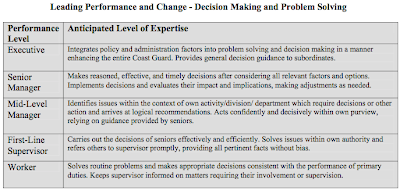The “spotlight on leadership” this week focuses on “decision making and problem solving,” begging the question, how do we involve others in decisions while still making good judgements when it is time to commit to action? Go ahead, I await your thoughts…
There is a lot more to decision making and problem solving than that, but as I re-familiarized myself with what the U.S. Coast Guard Leadership Development Framework (as you may know, one of my standard go-to “bibles” on leadership), that was the question that jumped out at me. The framework says the following of this key competency…
Leaders identify and analyze problems; use facts, input from others, and sound reasoning to reach conclusions; explore various alternative solutions; distinguish between relevant and irrelevant information; perceive the impact and implications of decisions; and commit to action, even in uncertain situations, to accomplish organizational goals. They evaluate risk levels, create risk control alternatives, and implement risk controls. Successful leaders are able to isolate high-importance issues, analyze pertinent information, involve others in decisions that affect them, generate promising solutions, and consistently render judgments with lasting, positive impact.
Of course there are so many different approaches to take here. Robin Blandford’s Decisions for Heroes software puts a solid tool and strong data into the hands of emergency first-responders making though calls in training and at the time of the incident. The folks at the Excellence in Government Conference I attended earlier this week made quite a strong case for leadership (and, by extension, the making of decisions and solving of problems) through relationships. Ultimately, though, the challenge is to use the best data and tools you have available in making a basically human judgement. What are the critical challenges and what is just a distraction? Where must we focus our resources, and what resources must be applied? How will we control risk as best we can, involve others in the solution, make a good judgement, and executive towards “lasting, positive impact?” So I ask you to consider once again:
How do we involve others in decisions while still making good judgements when it is time to commit to action?
…And consider the diagram below (click the image to enlarge) if you’re trying to evaluate yourself, your skills and tendencies in the context of your own job, so that you can get and idea of where to go next.





Leave a Reply
You must be logged in to post a comment.